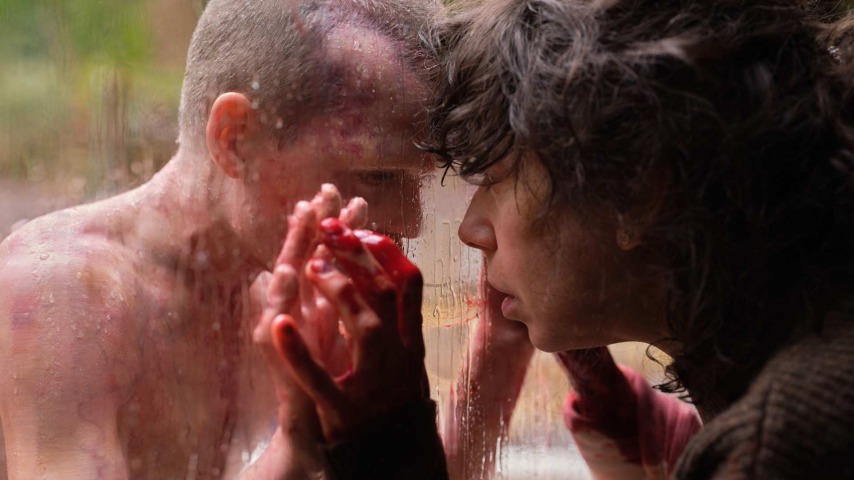Bring Her Back has a setup as simple as a fairy tale. Following the death of their father, brother and sister Andy (Billy Barratt) and Piper (Sora Wong), find themselves in the stead of a witch (Sally Hawkins) living in a secluded house in the woods. It’s a Grimm tale as old as time, made into a grimmer movie. In a marked improvement from their debut, Talk To Me, directors Danny and Michael Philippou use the cliché premise as a foundation for unrelenting tension, with a remarkably manic turn from Hawkins at the center. The filmmakers and their star dial the film to a slow boil that eventually turns into a grease fire.
Hawkins plays Laura, who assumes guardianship of 17-year-old Andy, who has a history of childhood violence, and preteen Piper, who has low vision. Weaponizing her Happy-Go-Lucky screen persona, Hawkins welcomes her new foster children with open arms, encouraging them to take selfies, pet her taxidermized dog, and meet fellow foster child Oliver (Jonah Wren Phillips). Inheriting the dead-eyed presence of Hereditary‘s tongue-clicking kiddo, Ollie is “selectively” mute, hungry as hell, and willing to eat anything—animal, mineral, or, in the film’s most harrowing and viscerally taxing sequence, utensil. When he’s not dragging Laura’s poor housecat to the mysteriously empty backyard pool, Oliver can be found with Laura, watching grainy VHS tapes of a cult’s blood ritual and home movies of Laura’s deceased daughter, Cathy (Mischa Heywood).
Yes, Bring Her Back is another horror movie about grief and trauma, and the title more or less gives away Laura’s plan. However, in the Philippou brothers’ hands, Bring Her Back‘s hackneyed plotting becomes solid ground for Hawkins’ layered performance and the directors’ merciless body horror. Even for seasoned horror professionals, Bring Her Back‘s grating visuals and sound design might prove too much, making viewers choose between covering their eyes or ears. It’s made all the worse that the primary victims are children.
While the directors can rely too much on close-ups to create a sense of claustrophobia, they find an aesthetic resonance when approximating Piper’s vision. A deliberately defocused camera and rain-soaked window panes obfuscate the ceremony Laura builds toward, allowing the audience to stay situated in Piper and Andy’s heads as they wander into Laura’s movie unsuspectingly. Editor Geoff Lamb’s rhythms offer an opaque view into Laura’s head, interspersing her VHS diet throughout the film with quick shots of aging, half-naked cultists performing ritualized murders in chalk circles. Echoes from the tapes spring up around Laura’s house, calling attention to the various features that go unremarked upon. Why can’t Ollie cross the giant chalk circle enclosing the house, and why is the pool empty? The Philippous allow these rote horror elements to simply serve as anchors for the performances and violent setpieces, which elevate the material beyond Danny Philippou and Bill Hinzman’s script.
Grief powers the movie, but it’s driven mainly by Andy, who suspects Laura might not have their best interests in mind. He needs only to look at Oliver for evidence of her malevolence; his physical transformation echoes Reagan from The Exorcist as he gnaws at himself and anything he can put in his maw. (Those with misophonia might have difficulty living through the mouth sounds in this one.) Laura’s abuse of Andy is far more grounded. Her manipulation begins immediately and becomes more personal and physical as the film continues. She lulls him into brief moments of stability before reminding him that one slip-up could separate him from Piper forever, while creating a wedge between the traumatized siblings. As Piper’s eyes, Andy protects her and gives the movie its emotional spine as he attempts to paint a prettier picture of the nightmare they’re currently inhabiting. Yet, despite their connection offering some daylight amid the movie’s torrential tonal downpour, Bring Her Back is far too tragic to find any sense of calm in their relationship. Hawkins, through her What Ever Happened To Baby Jane? madness, offers fleeting traces of pained regret as she puts her plan in motion, making her every move all the more painful.
The Philippous escalate the tension carefully, choosing the right moments to tear into their characters. Bring Her Back becomes increasingly brutal as it veers into its last act, but it also adds too many swerves, layering up twists that don’t amount to much. Some land better than others, but the movie works best on a visceral and emotional level, carried by Hawkins’ mania and the textured sound design that feels like pouring glass in the ear canal. Like a punk band turning four chords into pure angst, Bring Her Back turns familiar trauma-based horror into a traumatic experience. To sit through Bring Her Back is to endure it.
Director: Danny Philippou, Michael Philippou
Writer: Danny Philippou, Bill Hinzman
Starring: Billy Barratt, Sora Wong, Jonah Wren Phillips, Sally-Anne Upton, Stephen Phillips, Mischa Heywood, Sally Hawkins
Release Date: May 30, 2025


 Keep scrolling for more great stories from A.V. Club.
Keep scrolling for more great stories from A.V. Club.